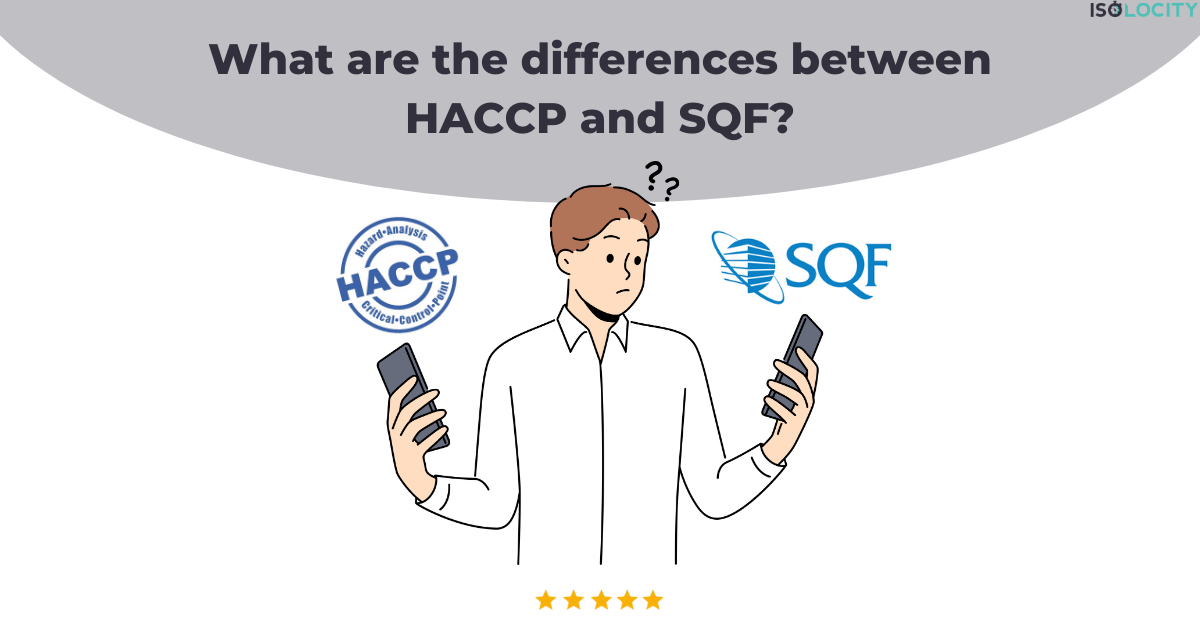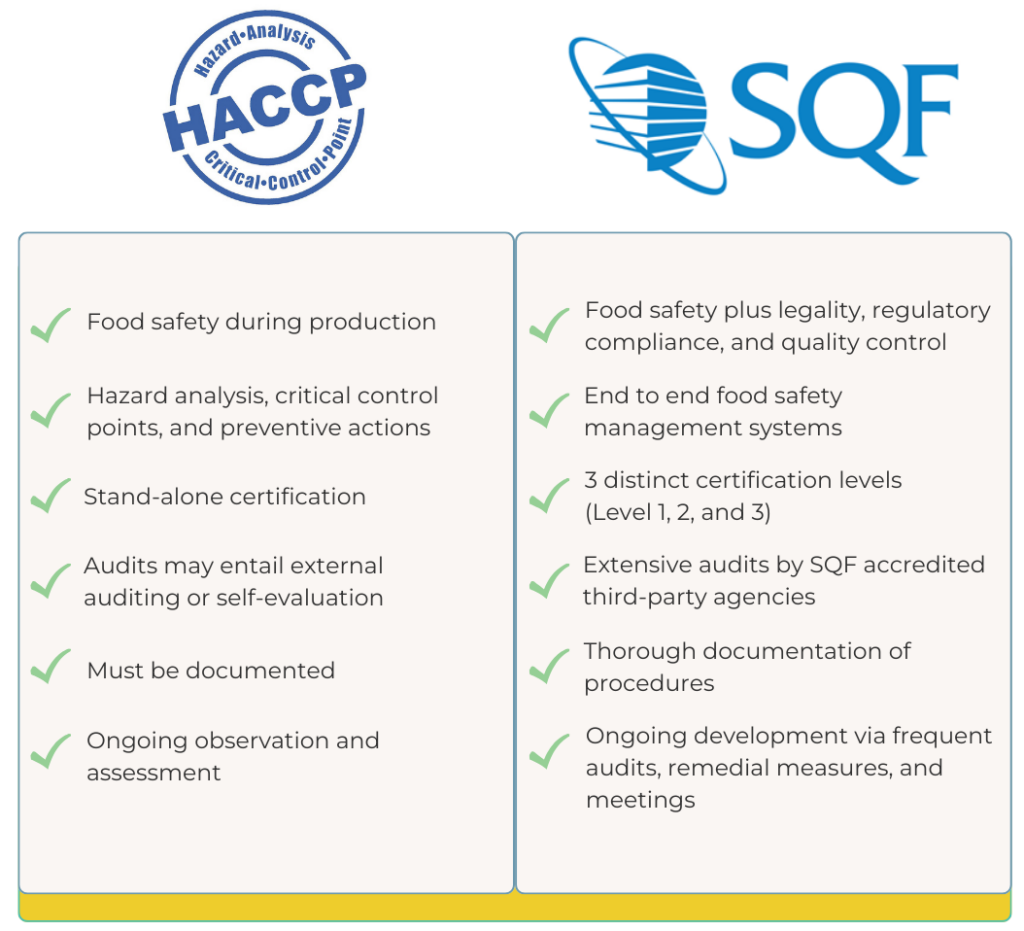If you’re passionate about food safety, chances are you’re familiar with the HACCP and SQF compliance requirements. Ensuring the safety and quality of food is paramount to any food and beverage company. However, understanding the differences between HACCP and SQF, despite their similar goals, can be confusing. Let’s simplify:
Think of HACCP as a careful chef who checks every item and process step several times to make sure nothing is missed. Preventive steps are just as important as identifying potential threats; it’s like having a safety net to protect your food.
That’s when SQF becomes more competitive. It feels as though a group of professionals is closely observing every facet of your dinner, from the farm to the table. Food safety is very important, but SQF goes above and beyond. It is essential to guarantee excellent quality and scrupulous attention to all instructions.
The main goal of HACCP is to guarantee food safety during the manufacturing process. SQF employs a comprehensive methodology, taking into account the complete process from the farm to the table. Not only is every bite delightful, but it is also assured to be high-quality and safe from contamination.
Check out our two blog posts, where we go into great detail about these two methods, here.
Let us now delve deeper into the differences between SQF and HACCP.
Not fond of reading? Check out the video!
Differences between HACCP and SQF
However, the main difference between SQF and HACCP is that SQF offers a comprehensive approach to food safety management by integrating food safety, quality, and legal compliance throughout the supply chain. Meanwhile, HACCP concentrates on preventing food safety hazards at critical points in the production process. Let’s explore each feature in more detail.
1. Scope:
HACCP: Is primarily concerned with locating and addressing risks to food safety during production.
SQF: Goes beyond food safety to cover legality, regulatory compliance, and quality control.
2. Methodology:
HACCP: Hazard analysis, critical control points, and preventive actions are the main components of HACCP, which emphasizes a preventive approach.
SQF: Uses a complete approach to management systems, combining regulatory requirements, food safety, and quality into an organized framework.
3. Levels of Certification:
HACCP: Does not offer levels for its stand-alone certification.
SQF: Offers three distinct certification levels (Level 1, 2, and 3), enabling businesses to select the best level in accordance with their requirements and capacity. Depending on where your organization resides in the supply chain, there are specific SQF guidelines you must follow.
4. Auditing
HACCP: Depending on legal requirements, audits may entail external auditing or self-evaluation.
SQF: The Safe Quality Food Institute-accredited third-party certification agencies perform extensive audits as part of the certification process.
5. Requirements and Documentation:
HACCP: Hazard analysis, important control points, monitoring protocols, and corrective measures must all be documented according to HACCP.
SQF: Consists of thorough documentation of procedures for supplier management, legal compliance, traceability, food safety, and quality.
6. Ongoing Enhancement:
HACCP: Places a strong emphasis on ongoing observation and assessment of the HACCP plan’s efficacy.
SQF: Promotes ongoing development via frequent audits, remedial measures, and meetings for management reviews.
Differences between HACCP and SQF : Example
Let’s think about a food production company that makes canned soup.
HACCP Application:
- The business detects possible risks during ingredient handling, such as microbial contamination.
- In order to regulate microbial development, critical control points are developed during the cooking and cooling phases.
- Temperature checks are part of monitoring processes at crucial control points.
- If there are temperature variations, corrective measures, including modifying cooking periods, are specified.
- Verification entails routinely checking temperature logs and testing completed goods for microbes.
SQF Application:
- In addition to following HACCP guidelines, the business uses SQF Level 2 certification.
- Equipment maintenance, product testing, and employee training are all interwoven into quality management procedures.
- Respecting food safety guidelines and labelling laws assures legal compliance.
- Systems of traceability are used to monitor ingredients as they move from suppliers to finished goods.
- Programs for managing suppliers are designed to guarantee the security and quality of raw materials.
- Regular audits, management evaluations, and customer feedback analysis are all part of continuous improvement projects.
Differences between HACCP and SQF : Tabular Format
| Aspect | HACCP | SQF |
| Scope | Focuses on food safety hazards | Extends to include quality, legality, and more |
| Approach | Preventive | Comprehensive management system |
| Certification Levels | Standalone | Level 1, 2, and 3 |
| Auditing | Self-assessment or external auditing | Third-party audits |
| Documentation | Hazard analysis, critical control points | Comprehensive documentation of various processes |
| Continuous Improvement | Emphasizes monitoring and verification | Regular audits and management reviews |
Conclusion:
While enhancing food safety is the common goal of both HACCP and SQF, their approaches, scopes, certification levels, auditing techniques, documentation needs, and continuous improvement processes vary. For businesses looking to guarantee not just food safety but also quality and legal compliance all the way through the supply chain, SQF provides a more complete framework.
Isolocity is a comprehensive food safety management system for SQF compliance whose features also encompass HACCP workflows. For additional information, please visit our food safety page. If you require any additional information, please contact us.










